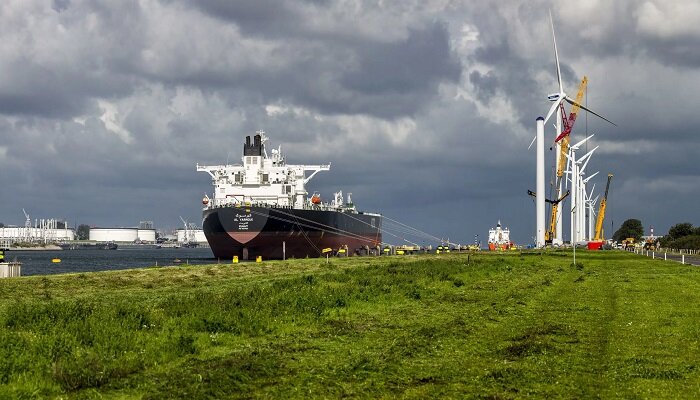In a world where green energy initiatives are gaining global momentum and significant construction projects are underway throughout North America, the competition to attract businesses in the maritime sectors of heavy lift, breakbulk, and project cargoes is generating its own dynamic energy.
The Port of San Diego has recently fortified its position in these sectors by enhancing its lifting capacity. It has acquired two state-of-the-art, all-electric Gottwald Generation 6 Mobile Harbor Cranes from Konecranes, which will replace the older diesel-powered crane at the Tenth Avenue Marine Terminal (TAMT). These pioneering all-electric cranes are set to become the first of their kind in North America and align with the port’s commitment to improving air quality.
The commencement of operations for these cranes is expected later this year, following an investment of approximately $14 million in the cranes and an additional $8.9 million in essential electrical infrastructure upgrades.
Greg Borossay, the Principal for Maritime Business Development at the port, identified three primary motivations for acquiring these cranes: staying at the forefront of heavy lift equipment electrification, addressing environmental concerns by phasing out the old diesel crane, and expanding capacity to attract more business in the heavy lift and breakbulk sectors.
As a result of this investment, San Diego now boasts the most substantial lift capacity on the West Coast, spanning from Vancouver, Canada, to the Panama Canal. This strategic move positions the port favorably for handling project cargo, especially those weighing over 200 metric tons. With both new cranes operating in tandem, the port will have a combined lift capability of 400 metric tons. Furthermore, there will be eight crane positions on the dock and an additional four off the docks, as these cranes are versatile enough to support rail operations.
In San Diego, heavy lift, project cargo, and breakbulk shipments collectively constitute 12 to 15 percent of the total tonnage. This includes the handling of steel pipes, coils, H-beams, steel plates, and components for electrification projects in the U.S. Southwest, as well as project cargo originating from South Korea and Taiwan. Additionally, the port handles various project cargoes from Northern Europe, such as transformers and heavy equipment, primarily destined for electrification projects in Arizona, New Mexico, and Nevada. The port’s U.S. Ocean service deals with heavy lift, breakbulk, military equipment, and special project cargo shipments bound for South Korea and Japan.
Diversity in Cargo Handling
Port Tampa Bay takes pride in being Florida’s largest port for handling steel products, serving the construction, manufacturing, and mining industries. Wade Elliott, Senior Vice President of Marketing & Business Development, highlights the port’s involvement in processing, distributing, fabricating, and manufacturing steel products. Moreover, the port handles lumber for the home improvement and construction sectors.
Elliott also notes that the port has witnessed substantial growth in steel and other products related to the solar industry. Additionally, high-and-heavy construction equipment, often acquired from industrial equipment auctions in the region, is imported and exported through the port, utilizing its foreign trade zone.
Port Tampa Bay boasts 500,000 square feet of transit shed space, over 5,000 linear feet of berth space, and more than 100 acres of laydown area designated for breakbulk and project cargo. The port is expanding its laydown area at the new Eastport facility and planning the construction of up to 500,000 square feet of on-dock, transload warehouse capacity at its primary terminals on Hookers’ Point.
Over the past year, logistics provider Glovis launched a new roll-on/roll-off (ro-ro) service, transporting automobiles manufactured in Mexico. Furthermore, Ultrabulk offers regular breakbulk service for delivering lumber from Northern Europe.
Paul Anderson, President & CEO of Port Tampa Bay, emphasizes the port’s diversification across multiple lines of business, with breakbulk playing a critical role in this diversification strategy.
Infrastructure Enhancements
The Georgia Ports Authority (GPA) has handled 2.8 million tons of breakbulk cargo, accounting for eight percent of the 37.2 million tons of cargo managed by GPA so far this fiscal year. Most of the breakbulk cargo falls into categories like ro-ro, forest products, and rubber.
Heavy-lift cargo is handled at the port of Brunswick, where it arrives via ro-ro vessels at the Colonel’s Island Terminal before being loaded onto rail or multi-axle over-the-road chasses. To accommodate heavy cargoes and accommodate heavy-lift cranes, GPA is upgrading the adjacent paving near its near-dock rail.
Additional infrastructure enhancements at Brunswick include the replacement of a 50,000-square-foot cargo shed at the Mayor’s Point Terminal with a new 100,000-square-foot warehouse featuring modern life safety improvements and flooring upgrades capable of supporting heavier loads. This project is expected to be completed by mid-September and will be primarily dedicated to handling rubber imports.
GPA’s breakbulk cargoes encompass more than just rubber; they also include forest products and heavy equipment used in farming and construction. The deepwater port of Brunswick is strategically located as a gateway for the import and export of breakbulk cargo, thanks to its easy accessibility by road and rail.
Griff Lynch, Executive Director of GPA, emphasizes the importance of the authority’s ability to handle breakbulk cargo, offering logistics operators flexibility in terms of routing, schedules, and transportation costs. To accommodate increased ro-ro cargo handled by Wallenius Wilhelmsen, GPA is enhancing the Colonel’s Island Terminal by constructing 350,000 square feet of near-dock warehousing. Additionally, three more buildings and 85 acres of auto storage space are being developed on the south side of the island, increasing Colonel’s Island’s annual capacity from 1.2 million to 1.4 million units.
Epicenter of Offshore Wind
South Jersey Ports, operating four marine terminals across southern New Jersey, specializes in bulk, breakbulk, and project cargo handling, managing over four million tons of cargo annually. Key cargoes include wood products, cement, cocoa beans, and steel. In line with the global trend toward wind energy development, South Jersey Ports is positioning itself as a hub for the offshore wind industry.
Paulsboro Marine Terminal, in particular, will play a crucial role in handling the monopiles for Ørsted’s Ocean Wind 1 offshore wind project. This project involves the transportation of 98 monopiles, each weighing approximately 1,500 tons and standing nearly 500 feet tall.
The EEW Group, a prominent monopile manufacturer based in Germany, has established an American affiliate, EEW AOS, at Paulsboro Marine Terminal. The company has already completed Phase 1 of its manufacturing plant, comprising a weld building and a coating facility. Phase 2 will see the entire manufacturing process, from importing raw materials to rolling steel, taking place at the Paulsboro Marine Terminal.
The port of Galveston is also reaping the rewards of the global push for green energy. It has long been a major U.S. importer of wind turbine components, and with extended federal tax credits for wind energy projects, the port anticipates continued growth in the handling of heavy-lift cargo for wind turbines. This growth is also positively impacting labor unions in Galveston, as breakbulk and ro-ro cargo operations require skilled labor. The port’s labor unions possess years of experience in efficiently moving these specialized cargoes from ships to trucks and rail.
Additionally, Galveston has experienced significant growth in ro-ro and breakbulk imports in the first half of 2023, with new vehicle tonnage increasing by 113 percent compared to the previous year and ro-ro cargo rising by 10 percent.
Cargo Insurance
While ports worldwide focus on strategies to ensure clean air, shippers and cargo owners seek a different type of insurance – coverage for the value of their products against a variety of potential transit-related risks. The upcoming Houston Marine & Energy Insurance Conference, scheduled for September 24-26, provides a platform for exploring insurance programs. The conference brings together leading experts in the marine, energy, insurance, and admiralty law industries and serves as a premier gathering for the global marine and energy insurance business.
Steven Weiss, President of Steven P. Weiss Consulting Inc., with extensive experience in ocean and inland marine insurance, including over 32 years as a marine surveyor, loss adjuster, direct insurance, and reinsurance underwriter, offers valuable insights when seeking cargo insurance.
Weiss advises against solely focusing on cost when considering insurance. While freight forwarders may suggest coverage under their liability policies, this coverage is often limited, making it preferable to invest in all-risk coverage, albeit with specific exclusions. Honesty is crucial when filling out insurance applications, as misrepresentation can lead to policy cancellations retroactively if relevant to a loss. It’s essential to accurately list all expected cargo movements, both in terms of volume per year and per shipment. Evaluating the need for stock coverage is also essential. Weiss notes that catastrophic exposure coverage may come at a higher cost than in previous years.
Different types of cargo have varying susceptibilities to damage, with most cargo-related damage stemming from inadequate packing. Thus, choosing reputable packers and freight forwarders is critical. Reviewing their processes, procedures, and liability insurance is recommended. Additionally, selecting the most appropriate mode of transportation, whether it’s by truck, rail, barge, ship, airplane, or a combination, can significantly impact the safety of cargo. Marine surveyors can provide valuable guidance in developing packing guidelines and improving cargo protection in case of consistent losses.


































